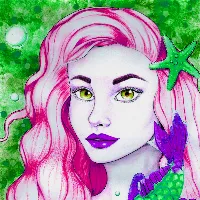I always found these coins a bit strange, as they are minted from aluminum, something I had never seen before, nor since. As such, they are extremely light-weight and the impressions are not as "crisp" as they would be on coins stamped from a harder metal.
In the Slavic languages, "jug" (pronounced: yoog) means "south." So, "Yugoslavia" (as we write it in English, and written "JУГОСЛАВИJА" in Cyrillic) means "Land of the Southern Slavs" to distinguish the residents as a separate people from the Slavic folk who live in other regions such as Czechia, Slovakia, Poland, Belarus, Lithuania, Ukraine, and Russia.
Several countries have a unit of currency called the dinar, but they are not related, nor are they necessarily valued the same, and the FPR Yulogoslavia is one of them.
The English word "dinar" is the transliteration of the Arabic دينار (dīnār), which was borrowed via the Syriac dīnarā from the Greek δηνάριον (dēnárion), itself from the Latin dēnārius. [3]
One of the Yugoslav coins I have is a 1 Dinar (KM# 30). On the obverse (front) is the name of the republic, written in the Cyrillic alphabet: "ФЕДЕРАТИВHА НАРОДНА РЕПУБЛИКА JУГОСЛАВИJА" ("THE FEDERATIVE OF THE PEOPLE'S REPUBLIC JUGOSLAVIJA") with the national emblem in the center.
The reverse (back) of the coin features seven stars across the top, the denomination "1 DINAR" in large characters, and the date of minting (1953) on the left and right sides. The odd thing to me about this coin (besides the fact that it is minted in aluminum) is that the country name on the obverse is written in Cyrillic letters, but the denomination "DINAR" is written in Latin letters rather than the Cyrillic "ДИНАР." I often wonder about small details like this... 😆
The Yugoslav Dinar is divided 100 Para, and I have a 50 Para coin (KM# 29) in my collection, too. On the obverse (front) is the national emblem, surrounded by the name of the country, but this time in Latin alphabet: "FEDERATIVNA NARODNA REPUBLIKA JUGOSLAVIJA" ("Federal People's Republic of Yugoslavia").
The reverse (back) of the 50 Para coin has the same quirk as the 1 Dinar coin, but in reverse — the denomination is in Cyrillic lettering: "50 ПАРА" ("50 PARA") rather than Latin lettering like the name of the country.
So, have you encountered any aluminum coins? If so, tell us about them in the comments!
SOURCES 1 Numista: 1 Dinar FNR legend 2 Numista: 50 Para FNR legend 3 Wikipedia: Dinar 4 Wikipedia: Yugoslav Dinar
a big hug to @enginewitty for designing the following personal banner for me 🤗
https://steemitimages.com/0x0/https://cdn.steemitimages.com/DQmPM1JABtfbJDy4G5ZEGysVtoz9nNYGtJGPB6sGcHTVHtc/#thealliance%[email protected]

Return from Coins from FPR Yugoslavia to 𝕜𝕚𝕥𝕥𝕪's Web3 Blog



